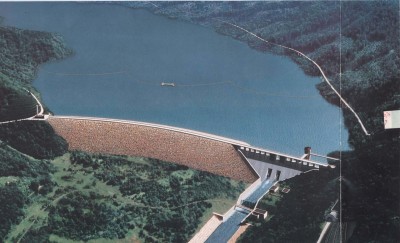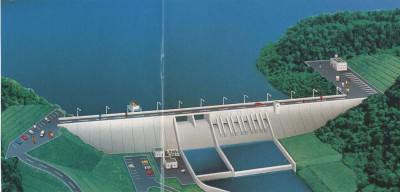| |
行事報告
I would like to start this dissertation with my deepest
gratitude and indebtedness to my professor, for his invaluable
advice, guidance and kind encouragement throughout my studying
in Japan, such as the study tour at Hokkaido. The study tour
at Hokkaido was very important, because I can improve my
understanding of dam engineering. Especially, I am much
obliged for Mr. KURODA HIKARU (黒田 晃 様, 日本工営会長) is the
president of Japan Society of dam ngineering, that submitted
me for participating this study tour, and Mr. KATSUYUKI UEDA
(上田勝幸 様, 大成.地崎.竹中JV忠別ダム作業所長) provided me with some documents
of dam engineering. Word of thank must also go to members of
whose participated with on this study tour at Hokkaido such
as: Mr. HAGA TOSHICHI (芳賀 敏二 様, 北海道開発局忠別ダム建設事業所長), Mr.
YACHIMA KUNINORI (矢島 国紀 様, 日本ダム協会常務理事) and another person,
that provided me with some good ideas of dam engineering.
Before I describe about my study tour at Hokkaido, I would
like to inform you, what I was studied at my home country.
Five years, I studied a dam engineering and my thesis was the
micro hydroelectric station, that the electric power could
provide 900KW. All kind of dam was studied such as earth dam
concrete dam, etc. The concrete dam was the best important of
my studying, but my understanding had a limited. This case, I
would like to improve my understanding of dam engineering,
because I still have some problems about it. For example, the
classification of concrete for types I, II, III, they are
complicated for me, because these types need who had a lot of
experiences. Japan is the country has a high level of
technology of concrete engineering, such as dams, bridges,
etc. So I hope that, I will be able to improve my
understanding in Japan.
The energy crisis produced by the increased priced of oil has
led to a worldwide renewal of interest in all exploitable
energy resources. Hydroelectricity is one are which has seen a
great resurgence of interest, to such an extent that all
countries with hydraulic resources are now seriously
considering the development of low and middle power
hydroelectricity. The developing countries, which have been
very seriously affected by the oil price rises (and which also
have technical difficulties in maintaining diesel generators),
are encouraging the increased use of hydroelectric power
through developing a better knowledge of their available water
resources. Hydraulic power is a form of non polluting solar
energy which can easily converted into electricity of up to
70%.
At my home country, the diesel generators make many problems,
such as the oil price rises, the problems of nvironment such
as pollution, etc. The Cambodia government has any plan to
construct and reconstruct the ydroelectric station, that it is
the best way to solve the social problems. Especially, it not
provides only a electric power, but it can provides the
important points such as: the irrigation system, water supply,
flood control, etc. Every year, we have many problems about
the flood, because many dams were destroyed by war. This year,
the Cambodia and Japan government had signed together to
reconstruct the Prek Thnot dam, that it will be able to
provide the electric power 30 MW, and will be able to develop
the irrigation systems on this areas. This case, the study
tour at Hokkaido was very important for me, that I can improve
my experience.
The first day, we visited the underconstruction of Chubetsu
dam. As a multi purpose dam under the jurisdiction of the
ministry of construction, Chubetsu dam will be constructed as
part of the Ishikari river comprehensive development project.

Figure1: Chubetsu dam
Figure1, the dam site has the following characteristics: the
riverbed is approximately 600 meters wide and require a wide
dam body, the site is almost entirely covered with a larger of
gravel as thick as 40 meters at the riverbed, and it was
necessary to evaluate the site¢s suitability as a dam
foundation and to examine methods of making the foundation
impermeable to water. The condition of its foundation rock,
pyroxene, is complex and there are some metamorphic parts. As
a result, it was decided to make it a composite dam with a
gravity type concrete dam section on the left bank and a
center core type fill dam section using part of the gravel
layer as its foundation on the right bank. The adoption of
large scale of underground diaphragm wall, to make the
foundation impermeable to water is a breakthrough idea. The
capability of Chubetsu dam can provide such as: the flood
control of discharge 1,600 m3/sec of water flowing to the dam
by thawing or flooding may be 860 m3/sec will be stored at the
dam to prevent flood damage on the Chubetsu river and the
Ishikari river into which the former flows. The dam will
supply the agricultural water for approximately 21,400 ha of
the irrigation system. It will be possible to take 70,000 m3
of water daily for water supply to this regions. The electric
power can provide 10 MW direct under the dam.

Figure2 : Takisato dam
The next day after visited Chubetsu dam, we went to visit
another dam. The Takisato dam will be completed on this year.
This dam is a multi purpose dam in the Ishikari river was
integrated development project and directly managed by the
ministry of construction. Figure2, it is being constructed on
the Sorachi river of the Ishikari river system. The Sorachi
river flows through the cities of Ashibetsu and Furano near
the center of Hokkaido. Takisato dam is a 50 high and 445
meters long concrete gravity dam with volume of 455,000m3, and
a reservoir capacity of 108,000 m3. The purpose of the dam is
to provide flood control, maintenance of river water
functions, water supply, irrigation system, electric power can
provided 57 MW of power from station, etc. Great damage due to
the unprecedented floods in August of 1975 and 1981 forced
revisions of the master plan for river works of the Ishikari
river system in March 1982. The revised plans included the
construction of the Takisato dam and master plan was approved
in September 1984 in accordance with the specific multi
purpose of dam law.
(関西大学大学院生 チ-.ニアラレン)
|



